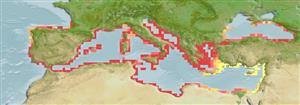>
Syngnathiformes (Pipefishes and seahorses) >
Syngnathidae (Pipefishes and seahorses) > Syngnathinae
Etymology: Syngnathus: Greek, syn, symphysis = grown together + Greek, gnathos = jaw (Ref. 45335).
More on author: Risso.
Issue
Syngnathus caspius Eichwald, 1831, was considered a synonym of Syngnathus abaster Risso, 1827. Reconsidered as a valid species since 2009 in various ichthyofaunas without compelling evidence until Zarei et al. (2021: Ref. 130571) used genetic characters (see the introduction for a complete history of the taxonomy). Information under Syngnathus abaster to be reviewed in FB.
Environment: milieu / climate zone / depth range / distribution range
Ecologie
marien; zoet water; brak water demersaal; amphidromous? (Ref. 51243); diepte 0 - 5 m (Ref. 6733). Subtropical; 45°N - 30°N, 10°W - 42°E
Eastern Atlantic: southern Biscay to Gibraltar, and also the Mediterranean and Black seas. Introduced and became established in the former USSR.
Grootte / Gewicht / Leeftijd
Maturity: Lm ? range ? - ? cm
Max length : 22.1 cm SL mannelijk / geslacht onbekend; (Ref. 94846)
Euryhaline, found among detritus or vegetation over sand or mud, within a temperature range of 8° to 24°C. Probably an amphidromous species (Ref. 51243) but migratory behavior needs verification. Ovoviviparous (Ref. 205). The male carries the eggs in a brood pouch which is found under the tail (Ref. 205). Early free-living young measure 23 mm TL (Ref. 6733).
Females lay 10-60 eggs into a brood pouch on ventral surface of tail of males. Males fertilize the eggs as they enter the pouch. Eggs incubate in the male´s brood pouch for about 20-32 days, depending of temperature. (Ref.59043).
Dawson, C.E., 1986. Syngnathidae. p. 628-639. In P.J.P. Whitehead, M.-L. Bauchot, J.-C. Hureau, J. Nielsen and E. Tortonese (eds.) Fishes of the North-eastern Atlantic and the Mediterranean. Volume 2. Unesco, Paris. (Ref. 6733)
Status op de Rode Lijst van het IUCN (Ref. 130435)
Gevaar voor de mens
Harmless
Gebruik door de mens
Tools
Speciale rapporten
Download XML
Internetbronnen
Estimates based on models
Preferred temperature (Ref.
123201): 15.2 - 21.4, mean 18.8 °C (based on 552 cells).
Fylogenetische diversiteitsindex (Ref.
82804): PD
50 = 0.5000 [Uniqueness, from 0.5 = low to 2.0 = high].
Bayesian length-weight: a=0.00025 (0.00020 - 0.00031), b=3.23 (3.18 - 3.28), in cm total length, based on LWR estimates for this species (Ref.
93245).
Trofisch niveau (Ref.
69278): 3.2 ±0.40 se; based on food items.
Generation time: 1.5 ( na - na) years. Estimated as median ln(3)/K based on 1
growth studies.
Weerstandsvermogen (Ref.
120179): Hoog, minimale populatieverdubbelingstijd minder dan 15 maanden (Preliminary K or Fecundity.).
Fishing Vulnerability (Ref.
59153): Moderate vulnerability (36 of 100).
Nutrients (Ref.
124155): Calcium = 206 [103, 448] mg/100g; Iron = 1.65 [0.97, 2.99] mg/100g; Protein = 18 [17, 19] %; Omega3 = 0.242 [0.130, 0.441] g/100g; Selenium = 15.7 [7.5, 33.6] μg/100g; VitaminA = 18.7 [6.9, 52.8] μg/100g; Zinc = 1.23 [0.82, 1.82] mg/100g (wet weight);
